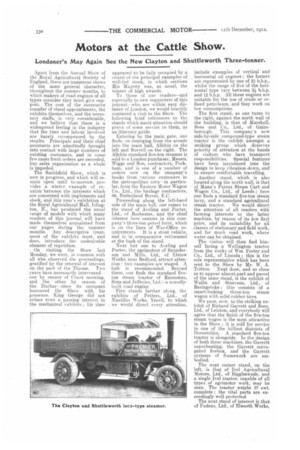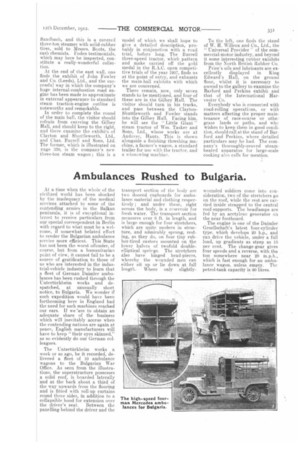Motors at the Cattle Show.
Page 18

Page 19

If you've noticed an error in this article please click here to report it so we can fix it.
Londoner's May Again See the New Clayton and Shuttleworth Three-tonner.
Apart from the Annual Show of the Royal Agricultural Society of England, there are numerous shows of the same general character, throughout the summer months, to which makers of road engines of all types consider they must give support. The cost of the successive transfer of stand appointments, the exhibits themselves, and the necessary staffs, is very considerable, and we believe that there is a widespread feeling in the industry that the time and labour involved are barely recompensed by the results. Principals and their chief assistants are admittedly brought into contact with large numbers of existing customers, and in some few cases fresh orders are recorded, but sales organization as a whole is impeded.
The Smithfield Show, which is now in progress, and which will remain open until to-morrow, provides a winter example of reunion between the interests which are concerned with implements and stock, and this year's exhibition at the Royal Agricultural Hall, Islington, N., has produced the usual range of models with which many readers of this journal will have made themselves acquainted from our pages during the summer months. Any descriptive treatment of the exhibits must, and does, introduce the undesirable element of repetition.
On visiting the Show last Monday, we were, in common with all who observed the proceedings, gratified by the renewal of interest on the part of the Throne. Two years have necessarily intervened one by reason of Court morning, and the other by reason of the Durbar—since its occupant honoured the Show with his presence. Ring George did not evince even a passing interest in the mechanical exhibits ; his time appeared to be fully occupied by a round of the principal examples of well-fed stock, in which sections His Majesty was, as usual, the winner of high awards. To those of our readers—and especially to new supporters of this journal—who are within easy distance of London, we would heartily oommend a visit to the Show. The following brief references to the stands which merit attention should prove of some service to them, as an itinerary guide. Entering by the main gate, one finds, on emerging from the arcade into, the main hall, Allchin on the left and Burrell on the right. The Allchin standard five-ton steamer is sold to a London purchaser, Messrs. Wiggs and Son, contractors, Peckham, and is one of a number of orders now on the company's books from various customers in the metropolitan area--in particular, from the Eastern Motor Wagon Co., Ltd., the haulage contractors, 66, Buttesland Street, E.C. Proceeding along the left-hand side of the main hall, one comes to the stand of Aveling and Porter, Ltd., of Rochester, and the chief interest here centres in this company's three-ton petrol lorry, which is on the lines of War-Office re quirements. It is a stout vehicle, and is in comparative retirement at the back of the stand.
Next but one to Aveling and Porter, the agrimotors of Saunderson and Mills, Ltd., of Elstow Works, near Bedford, attract attention.: two examples are staged. A halt is recommended. Beyond these, one finds the standard fiveton steam tractor of Ransomes, Sims and Jefferies, Ltd.—a soundlybuilt road engine.
Five stands farther along, the exhibits of Petters, Ltd., of Nautilus Works, Yeovil, to which we would direct every attention
include examples of vertical and horizontal oil engines ; the former are represented by one of 25 b.h.p., whilst the range of five of the horizontal type vary between 2.1, b.h.p. and 12 b.h.p. All these engines are suitable for the use of crude or refined petroleum, and they work on low consumptions. The first stand, as one turns to the right, against the north wall of the building, is that of Marshall, Sons and Co., Ltd., of s Gainsborough. This company's new side-by-side compound-type steam tractor is the exhibit amongst a striking group which deserves priority of attention at the hands of visitors who have transport responsibilities. Special features have been introduced into the design to keep vibration down, and to ensure comfortable travelling.
Another stand, which is also located along the north wall, is that of Mann's Patent Steam Cart and Wagon Co., Ltd., of Leeds ; here one finds a standard five-ton steam lorry, and a standard agricultural steam tractor. We would direct the attention of all readers with farming interests to the latter machine, by reason of its low first price, and its suitability for all classes of stationary and field work, and for much road work, where water can be obtained.
The visitor will then find himself facing a Wellington tractor from the works of Wm. Foster and Co., Ltd., of Lincoln ; this is the sole representative which has been sent to the Show by Mr. W. A. Tritton. Next door, and so close as to appear almost part and parcel of the same stand, is the exhibit of Wallis and Steevens, Ltd., of Basingstoke; this consists of a smart-looking three-ton steam wagon with solid-rubber tires.
We pass, now, to the striking exhibit of Richard Garrett and Sons, Ltd., of Leiston, and everybody will agree that the finish of the five-ton steam wagon is the most attractive in the Show ; it is sold for service in one of the hilliest districts of Dorsetshire. A standard five-ton tractor is alongside. In the design of both these machines, the Garrett superheating, the Garrett corrugated firebox, and the Garrett systems of framework are embodied.
The next corner stand, on the left, is that of Ivel Agricultural Motors, Ltd., of Biggleswade, and a single Ivel tractor, capable of all types of agrimotor work, may be seen. The tractor weighs 37 cwt. complete; the vital parts are exceedingly well protected.
The next stand of interest is that of Fodens, Ltd., of Elworth Works, Samlbach, and this is a covered three-ton steamer with solid-rubber tires, sold to Messrs. Boots, the cash chemists. Forien testimonials. which may here be inspected, constitute a really-wonderful collection.
At the end of the east wall, one finds the exhibit of John Fowler and Co. (Leeds). Ltd., and the successful way in which the company's huge internal-combustion road engine has been made to approximate in external appearance to standard steam traction-engine outline is noteworthy and remarkable.
In order to complete the round of the main hall, the visitor should refrain from entering the Gilbey Hall, and should keep to the right, and there examine the exhibits of Clayton and Shuttleworth. Ltd., and Chas. Burrell and Sons, Ltd. The former, which is illustrated on page :130, is the company's new three-ton steam wagon ; this is a model of which we shall hope to give a detailed description, probably in Conjunction with a road trial, before long. The Burrell three-speed tractor, which pattern and make carried off the gold medal in the R.A.C. open competitive trials of the year 1907, finds us at the point of entry, and exhausts the main-hall exhibits with which we are concerned.
There remain, now, only seven stands to be mentioned, and four of these are in the Gilbey Hall. The visitor should turn in his tracks, and pass between the ClaytonShuttleworth and Fowler stands into the Gilbey Hall. Facing him, he will see the " Little Giant " steam tractor of Wm. Tasker and Sons, Ltd.. whose works are at Andover, Hants. This is shown alongside a finishing threshing machine, a farmer's wagon, a standard trailer for use with the tractor, and a winnowing machine. To the left, one finds the stand of W. H. Willcox and Co., Ltd., the " Universal Provider '' of the commercial-motor industry, and beyond it some interesting rubber exhibits from the North British Rubber Co.
Price's oils and lubricants are excellently displayed in King Edward's Hall, on the ground floor, whilst it is necessary to ascend to the gallery to examine the Barford and Perkins exhibit and that of the International Harvester Co.
Everybody who is connected with road-rolling operations, or with matters affecting the proper maintenance of race-course or othe;. grass lands or paths, and who wishes to keep them in good condition, should call at the stand of Barford and Perkins, where detailed particulars may be had. The company's thoroughly-nroved steamheated anparatus for large-scale cooking a!=o cells for mention.
























